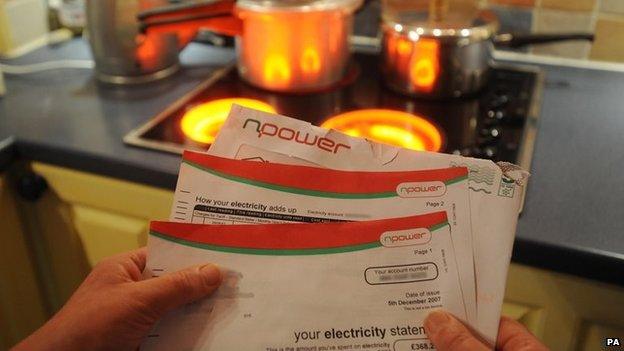Daily question: What might independence mean for the energy sector?
- Published
As the people of Scotland weigh up how to vote in the independence referendum, they are asking questions on a range of topics from the economy to welfare.
In this series, we are looking at those major questions and by using statistics, analysis and expert views shining a light on some of the possible answers.
Here, we focus on the issue of energy and the debate about what might happen if there is a "Yes" vote in the Scottish independence referendum.
Do you have a referendum question? Let us know by....
Emailing newsonlinescotland@bbc.co.uk.
We can also be found on Twitter @bbcscotlandnews, external
And on Facebook, external.
BBC news website user Graham Stephen asks: "Would our domestic energy bills be higher, lower or no different in an independent Scotland?". David Hanley questions: "Is any party brave enough to stand up and say that the key to future prosperity lies in securing the energy sector revenues. Is there an elephant in the room called Nationalisation?" Also asking questions related to energy are David Fright and Kevin Thomas.

How does Scotland generate its electricity?

Scotland uses a mix of coal, gas, nuclear and renewable energy sources.
It has been moving away from burning fossil fuels, ie coal, gas and oil, to generate electricity. So, for example, the coal-fired power station at Cockenzie in East Lothian closed in March 2013 and the the oil-fired power station at Inverkip on the Firth of Clyde has been demolished. The high price of oil meant it was rarely used.
The Scottish government, which is opposed to the construction of new nuclear power stations in Scotland, is focusing on developing wind, wave, tidal and hydro generation.
Main sources of electricity generation in Scotland
Nuclear: 34%
-
Renewables: 30%
-
Coal: 25%
-
Gas: 8%
The role of the National Grid is to ensure a balance between electricity generation and the demand for power from consumers and businesses.
Scotland's existing nuclear power stations are used to provide "base load" electricity.
Output from the growing number of on-shore wind farms is variable.
The country's coal and gas-fired power stations can increase or decrease output to help balance supply and demand.
Pumped storage hydro schemes are used to store surplus energy when demand is low or output from wind farms is high, and generate electricity when demand from consumers increases.
Hydro schemes are becoming more important as our reliance on wind generation increases.

Is Scotland an exporter or importer of electricity?

Scotland is a net exporter of electricity.
There are times when Scotland imports electricity from the rest of the UK.
But Scotland exports more electricity than it imports over the course of a year.
In 2012, 26.1% of the electricity generated in Scotland was exported to the rest of the UK.

What are the Scottish government's energy targets?

The Scottish government wants the country to generate the equivalent of 100% of its annual electricity demand using only renewable sources by 2020.
But that does not mean Scotland would only use renewable energy. Coal, gas, and nuclear will still be part of Scotland's energy mix by 2020.
Scotland's energy targets as outlined by Energy in Scotland, A Compendium of Scottish Energy Statistics, include:
Electricity: Annual renewable electricity generation should be the equivalent of 100% of gross annual electricity consumption by 2020. (In 2012, the equivalent of 40% of gross electricity consumption was from renewable sources, up from 36.% in 2011.)
Transport: 10% share of biofuels in transport petrol and diesel consumption by 2020. (Biofuels had a 3% share of road fuels in the UK as a whole in 2012, down from 3.5% in 2010.)
Heat: 11% of heat demand to be met from renewable sources by 2020. (In 2011, about 3% of heat demand was met from renewable sources.)
Energy consumption: 12% reduction in total final energy consumption by 2020. (In 2011, consumption was 9% lower than the 2005-07 baseline.)

Will the lights stay on?

Maintaining reliable electricity supplies is a major challenge for countries across Europe.
Last year, the industry regulator Ofgem warned that spare generating capacity in the UK could fall to 2% by 2015.
Ofgem said tough emissions targets, the UK's increasing dependency on gas imports, and the closure of ageing power stations were contributing to the heightened risk of shortages.
The Scottish government insists Scotland would continue to export surplus electricity to the rest of the UK after independence.
The UK government argues the rest of the UK could chose to import electricity from other European countries instead.
In April, a report from the Scottish government said Scotland's natural resources could "help keep the lights on and energy bills down".

Would my electricity bills go up or down?

The impact of independence on electricity bills is disputed.
The single GB energy market means costs can be spread across 30 million households and businesses.
The current integrated system could not continue as it is now.
Household energy bills would increase by at least £38 per year.
Annual household bills could increase by up to £189 if the full cost of supporting renewable energy projects fell to Scottish bill payers.
England and Wales would not have to rely on imports of electricity from Scotland.
Scotland will continue to participate in the GB-wide market for electricity and gas.
Scottish generation is essential to ensuring the lights stay on across Britain.
Without Scottish generation and Scottish renewable energy, the spare capacity margin across the GB grid would already be in negative figures.
Policies to tackle fuel poverty and improve energy efficiency would be funded by the Scottish Government, rather than energy companies.
This would allow companies to reduce bills by around five per cent, or approximately £70, every year.

Who will pay for Scotland's renewable energy schemes?

Again, this is disputed by both sides in the independence debate.
The Scottish government says Scottish renewable energy is the most cost-effective source of low-carbon electricity, and enables the rest of the UK to meet its climate change targets.
In return, financial support for renewable energy schemes and the transmission network would be met by consumers across Britain.
The UK government says any decision to import energy from an independent Scotland would be taken on commercial basis.
That could leave consumers in Scotland to foot the bill for renewable energy schemes and investment in the transmission network.

Could the rest of the UK buy electricity somewhere else?

Yes. There are subsea cables, known as interconnectors, which allow electricity to be imported or exported to and from France, the Netherlands, and Ireland.
But capacity is limited to 4GW, or about 5% of Britain's generation capacity.
Other European countries, such as France, Germany and Belgium, are facing security of supply problems according to the industry regulator, Ofgem.
That means increased competition for supplies.
Electricity would only be sold to the country prepared to pay the highest price for it.
New interconnectors between Britain, Belgium, Norway, France, Denmark and Iceland have been proposed.

How do Scotland's climate change targets affect the power sector?

The Climate Change (Scotland) Act set a target of an 80% reduction in greenhouse gas emissions by 2050.
The interim target is a 42% reduction by 2020.
The calculations use 1990 as a baseline.
Scotland has repeatedly missed its annual climate change targets since the legislation was introduced in 2009.
But the Scottish government insists the country remains on track to achieve the 42% target by 2020.
The energy sector, and consumers, will have a major role to play if the overall targets are to be achieved.
The Scottish government's Climate Change Delivery Plan calls for a largely decarbonised electricity generation sector by 2030 and a largely decarbonised heat sector by 2050.